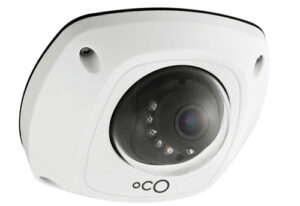 Ivideon provide a ‘Cloud’ based service for management of video camera images. The Oco Pro camera is configured to work with this service to allow live and recorded images to be displayed on PC using Mac OS, Windows or Linux and phone or tablet devices using both iOS and Android operating systems. The Ivideon website shows that they partner with a number of Chinese camera suppliers and list Hikvision, Dahua, Oco and Milesight. The Oco Pro camera dome tested here was based on a Hikvision model as evidenced by its MAC address.
Ivideon provide a ‘Cloud’ based service for management of video camera images. The Oco Pro camera is configured to work with this service to allow live and recorded images to be displayed on PC using Mac OS, Windows or Linux and phone or tablet devices using both iOS and Android operating systems. The Ivideon website shows that they partner with a number of Chinese camera suppliers and list Hikvision, Dahua, Oco and Milesight. The Oco Pro camera dome tested here was based on a Hikvision model as evidenced by its MAC address.
The Quick Set-up guide and Set-up manual are very simplistic and don’t provide any help if things don’t go as expected beyond giving contact details for their helpdesk.
The camera is a 2MP Day/Night dome with a 106° horizontal angle of view. It provides an HD 1920 x 1080 pixel-image and is weather-proof so is suitable for internal and external mounting.
Features
The system is based around Ivideon’s ‘Cloud’ software service for which there are a number of options for home or business users. Their home plans range from a free online plan giving 24 hours of basic event recording and up to three users through Cloud 1, Cloud 10 and Cloud 30 options providing increasing amounts of event recording of up to 30 days’ duration and five users.
The business plans start from a low-cost Online Pro with five days of basic event recording through Cloud 10 Pro, Cloud 30 Pro, Extended Pro and Broadcasting; these options provide up to 60 days of event recording and all allow for multiple users. Pricing is given in US$ only.
Signing up for the service is very simple with an e-mail account used as the user reference and a suitably secure personal password being entered. A couple of tick-boxes are presented to confirm agreement with one being for their Terms of Service & Privacy Policy and the second for accepting e-mail notifications and new feature promotions. The Terms of Service and Privacy Policy appeared to be available as hyperlinks as the terms were in blue text but this did not work so it was necessary to agree to their terms without gaining site of the actual documents. A search of their FAQ page did not reveal these documents either. It is often assumed that no one reads terms and conditions documents but if one is signing up for a business service that will potentially be depended upon for security images then this should be readily available. No information is given as to how and where these recording will be stored.
Once your account is set up you are able to log into the service and are presented with an ‘Add a camera’ screen to select the type of camera to be used, there are four options from Ivideon- powered camera, laptop or desktop webcam, regular IP camera or Ivideon-powered DVR.
With the Ivideon-powered camera selected, you are then prompted for a descriptive camera name to be entered along with the MAC address from the camera sticker. You are next prompted to “connect the camera using a network cable to a router with internet access”. This must be a suitable PoE connection or using an appropriate PoE injector or separate 12v power supply. The service should then find the camera and connect in approximately two minutes.
After a longer ‘time-out’ period the software prompted for the camera to be disconnected and re-powered with the message ‘Please wait while your camera boots up and connects to Ivideon’.
No mention is made of the likely need to configure port forwarding on the router to allow access between the Ivideon server and the camera. Once the router was configured the camera connected as expected. No mention appeared to be made of this likelihood on the Oco or Ivideon websites so it is likely that they would expect to advise users via their helpline.
Read the full review in the March edition of PSI magazine


